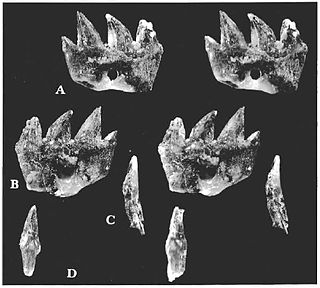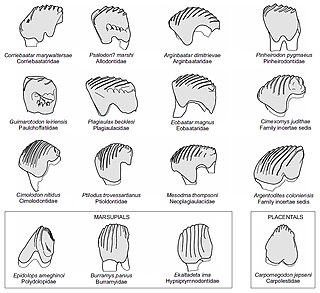
Didelphodon is a genus of stagodont metatherians from the Late Cretaceous of North America.

Repenomamus is a genus of opossum- to badger-sized gobiconodontid mammal containing two species, Repenomamus robustus and Repenomamus giganticus. Both species are known from fossils found in China that date to the early Cretaceous period, about 125-123.2 million years ago. R. robustus is one of several Mesozoic mammals for which there is good evidence that it fed on vertebrates, including dinosaurs. Though it is not entirely clear whether or not these animals primarily hunted live dinosaurs or scavenged dead ones, evidence for the former is present in fossilized remains showcasing the results of what was most likely a predation attempt by R. robustus directed at a specimen of the dinosaur Psittacosaurus lujiatunensis. R. giganticus is among the largest mammals known from the Mesozoic era, only surpassed by Patagomaia.

Pucadelphys is an extinct genus of non-marsupial metatherian. The genus contains a single species, P. andinus. Fossils of Pucadelphys have been found in the Santa Lucía Formation in Tiupampa in Bolivia.

Alphadon is an extinct genus of small, primitive mammal that was a member of the metatherians, a group of mammals that includes modern-day marsupials. Its fossils were first discovered and named by George Gaylord Simpson in 1929.

Eutriconodonta is an order of early mammals. Eutriconodonts existed in Asia, Africa, Europe, North and South America during the Jurassic and the Cretaceous periods. The order was named by Kermack et al. in 1973 as a replacement name for the paraphyletic Triconodonta.

Gobiconodontidae is a family of extinct mammals that ranged from the mid-Jurassic to the early Late Cretaceous, though most common during the Early Cretaceous. The Gobiconodontids form a diverse lineage of carnivorous non-therian mammals, and include some of the best preserved Mesozoic mammal specimens.

Deltatheridiidae is an extinct family of basal carnivorous metatherians that lived during the Cretaceous and Paleogene. They were closely related to marsupials. Their fossils are restricted to Central Asia and North America. They mostly disappeared in the KT event, but a ghost lineage, currently represented by Gurbanodelta, survived until the late Paleocene by decreasing in size and becoming insectivorous.
Nanocuris is an extinct genus of Deltatheridiidae from the Cretaceous of Canada (Saskatchewan) and United States. Initially, it was classified in a proper family, Nanocuridae, in the clade Eutheria, but a reanalysis of a new specimen revealed a delthatheroid affinity of the genus.

Stagodontidae is an extinct family of carnivorous metatherian mammals that inhabited North America and Europe during the late Cretaceous, and possibly to the Eocene in South America.

Pappotherium is an extinct genus of mammals from the Albian of Texas, US, known from a fossilized maxilla fragment bearing two tribosphenic molars, discovered within the Glen Rose Formation near Decatur, Wise County, Texas.

Siamoperadectes is a genus of non-marsupial metatherian from the Miocene of Thailand. A member of Peradectidae, it is the first member of its clade known from South Asia, and among the last non-marsupial metatherians.

Ichthyoconodon is an extinct genus of eutriconodont mammal from the Lower Cretaceous of Morocco. It is notable for having been found in a unique marine location, and the shape of its teeth suggests an unusual, potentially fish-eating ecological niche. Analysis suggests it is part of a group of gliding mammals that includes Volaticotherium.
Oxlestes is an extinct mammal from the Late Cretaceous of Asia, more specifically from the Cenomanian of Uzbekistan. A carnivorous species of uncertain affinities, it is notable for its relatively large size, being among the largest of all Mesozoic mammals. Due to the limited amount of material, it has been considered a nomen dubium.
Alticonodon is a genus of extinct mammal from the Late Cretaceous of North America. It is one of the geologically youngest known eutriconodonts, and is a fairly more specialised animal than earlier representatives of this clade.
The "Gurlin Tsav" skull is a currently unnamed carnivorous metatherian fossil from the Nemegt Formation of Mongolia. Composed of a single semi-complete skull, this specimen is notable in regards to the evolution and systematics of Metatheria as a whole, and thus nigh-omnipresent in phylogenetic analyses of this group.
Khuduklestes is a genus of extinct mammal of uncertain affinities from the Late Cretaceous of China. It is rather similar to the also carnivorous and taxonomically uncertain Oxlestes, being slightly smaller.

Tsagandelta is a genus of deltatheroidean therian mammal that lived in Asia during the Late Cretaceous. Distantly related to modern marsupials, it is part of Deltatheroida, a lineage of carnivorous metatherians common in the Cretaceous of Asia and among the most successful non-theropod carnivores of the region. It represents the first known mammal from the Bayan Shireh Formation.

A plagiaulacoid is a type of blade-like, most often serrated, tooth present in various mammal groups, usually a premolar. Among modern species it is present chiefly on diprotodontian marsupials, which have both the upper and lower first premolars converted into serrated blades. However, various other extinct groups also possessed plagiaulacoids. These would be multituberculates, some "Plesiadapiformes" such as Carpolestes and various metatherians such as Epidolops and various early diprotodontians. In many of these only a lower premolar became converted into a blade, while the upper premolars showed less specialisation.

Asiatherium is an extinct genus of mammal, probably belonging to Metatheria. It lived during the Late Cretaceous, and its fossilized remains were discovered in Mongolia.
Albertatherium is an extinct genus of alphadontid metatherians that lived during the Late Cretaceous of North America. The genus contains two species, Albertatherium primus, and Albertatherium secundus. Fossils have been found in the Eagle Formation of Montana and the Milk River Formation of Alberta.

















